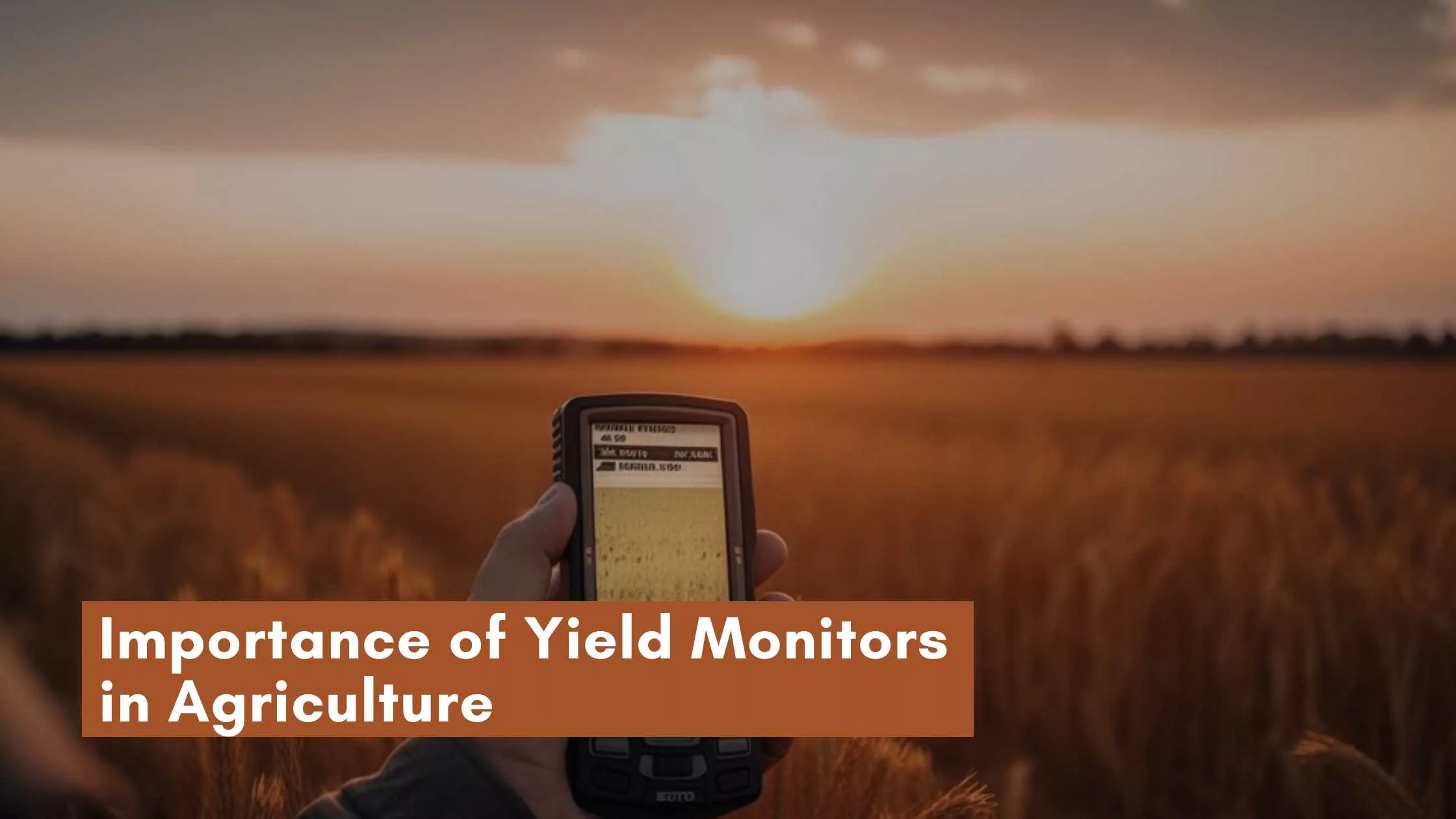What are yield monitors?
Yield monitors are devices or systems used in agriculture to measure and record the yield of crops during harvest. They are typically installed on harvesting equipment, such as combines or grain harvesters and collect data on crop yield, moisture content, and other related parameters.
The data collected by yield monitors helps farmers gather information about the performance of their crops, identify variations in yield across the field, and make informed decisions regarding crop management, resource allocation, and future planning.
Why use yield monitors in agriculture
Yield monitors are used in agriculture for several reasons:
Crop Performance Evaluation:
They provide accurate and detailed information about the yield of crops during harvest. By measuring and recording crop yield, farmers can evaluate the performance of different fields, varieties, or management practices. This data helps assess the effectiveness of various techniques and make informed decisions for future seasons.
Field Variability Analysis:
Yield monitors help identify variations in crop yield across the field. By mapping yield data, farmers can visualize and analyze the spatial variability in yield, which may be influenced by factors such as soil types, drainage patterns, nutrient levels, or pest pressure. Understanding field variability enables farmers to implement site-specific management strategies and optimize resource allocation for improved productivity.
Precision Agriculture:
Yield monitors play a crucial role in precision agriculture, which involves applying inputs and management practices with precision and site-specificity. By combining yield data with other spatial data layers (e.g., soil maps and satellite imagery), farmers can create prescription maps for variable rate applications of seeds, fertilizers, and pesticides. This targeted approach optimizes resource utilization, reduces input costs, minimizes environmental impact, and enhances overall efficiency.
Decision-Making and Planning:
The data collected by yield monitors is valuable for decision-making and long-term planning. By analyzing yield trends and historical data, farmers can identify patterns, assess the impact of management decisions, and develop strategies to address yield-limiting factors. This information guides crop selection, rotation planning, equipment investments, and other critical decisions for maximizing profitability and sustainability.
In summary, yield monitors provide farmers with accurate yield information, enable an analysis of field variability, support precision agriculture practices, and inform decision-making and planning for optimal crop management.
How can yield monitors improve crop production?
Yield monitors can improve crop production in several ways:
Precision Management:
Yield monitors provide accurate and detailed data on crop yield and field variability. This information allows farmers to implement precision management practices tailored to specific areas of their fields. Farmers can optimize resource allocation, reduce waste, and maximize crop production by targeting inputs like seeds, fertilizers, and pesticides.
Site-Specific Decision Making:
With the help of yield monitors, farmers can make informed decisions based on field-specific data. By analyzing yield maps and correlating them with other spatial information, such as soil maps or satellite imagery, farmers can identify areas with lower yields and determine the underlying causes. This allows for site-specific interventions, such as adjusting irrigation, applying targeted soil amendments, or implementing pest management strategies, leading to improved crop production.
Performance Evaluation:
Yield monitors enable farmers to evaluate the performance of different fields, crop varieties, or management practices. Farmers can identify which approaches deliver higher yields and profitability by comparing yields across different areas. This information helps select the most productive varieties, optimize planting densities, adjust fertilizer application rates, or modify other management practices to improve crop production.
Yield Trend Analysis:
Over time, yield monitors provide a historical record of crop yields. By analyzing yield trends, farmers can identify patterns and understand the impact of various factors on crop production. This helps detect long-term changes, evaluate the effectiveness of different interventions, and adjust strategies accordingly to improve crop production consistently.
Documentation and Reporting:
Yield monitors generate accurate and reliable records of crop yields. These records can be used for documentation, reporting to stakeholders (such as lenders or insurers), and complying with regulations. Access to historical yield data allows farmers to demonstrate their crop production capabilities, track performance over time, and make informed decisions for future planning.
By leveraging the information provided by yield monitors, farmers can implement precision management practices, make site-specific decisions, evaluate performance, analyze yield trends, and maintain accurate documentation. These actions collectively contribute to improved crop production, enhanced resource efficiency, and increased profitability in agriculture.
The function of a moisture sensor in yield monitor
The function of a moisture sensor in a yield monitor is to measure and record the moisture content of the harvested crop. The moisture content of crops, such as grains or fruits, is an essential parameter that affects their quality, storage, and market value. The moisture sensor integrated into a yield monitor helps farmers gather accurate and real-time information about the moisture content of the harvested crop, allowing them to make informed decisions during harvest and post-harvest processes.
These sensors typically use a measurement technique, such as capacitance, electrical resistance, or near-infrared spectroscopy, to determine the crop’s moisture content. The sensor is usually located in the flow path of the harvested crop, such as the grain elevator or conveyor, and measures the moisture content as the crop passes through.
The moisture data collected by the sensor is then combined with the corresponding yield data from the yield monitor. This integration provides a comprehensive understanding of the relationship between crop yield and moisture content. Farmers can use this information to make decisions regarding grain drying, storage conditions, blending different moisture contents for optimal marketability, and determining appropriate pricing for the crop.
By accurately measuring and recording the crop’s moisture content, the moisture sensor in a yield monitor enables farmers to manage their harvested crops effectively, ensure quality preservation, and optimize market value.
Importance of Yield Monitors in Agriculture
Yield monitors play a crucial role in modern agriculture due to the following reasons:
Enhanced Decision Making:
They provide farmers with accurate and detailed data on crop yields. This information helps evaluate the performance of different fields, crop varieties, or management practices. Farmers can make data-driven decisions regarding crop selection, resource allocation, and future planning by analyzing yield data, improving productivity and profitability.
Field Variability Analysis:
Yield monitors allow farmers to identify spatial variations in crop yield across their fields. Farmers can visualize and analyze field variability influenced by soil types, nutrient levels, drainage patterns, and pest pressure by mapping yield data. This information enables site-specific management strategies, such as variable rate applications of inputs, to optimize resource utilization and improve overall crop production.
Precision Agriculture Implementation:
These monitors are a critical component of precision agriculture. By combining yield data with other spatial data layers (e.g., soil maps and satellite imagery), farmers can create prescription maps for variable-rate applications of inputs like seeds, fertilizers, and pesticides. This precision approach minimizes input waste, reduces costs, and maximizes resource efficiency while minimizing environmental impact.
Performance Evaluation and Benchmarking:
Yield monitors allow farmers to compare the performance of different fields, crop varieties, or treatments. This information helps identify best practices, assess the impact of management decisions, and implement continuous improvement strategies. Farmers can set goals, track progress, and strive for higher yields and profitability by benchmarking yield data.
Documentation and Compliance:
Yield monitors provide documented records of crop yields, which are valuable for compliance with regulations, reporting to stakeholders (e.g., lenders and insurers), and demonstrating farming practices. Accurate yield data helps maintain transparency, ensure accountability, and meet regulatory requirements.
Research and Innovation:
They contribute to agricultural research and innovation by providing valuable data for studying crop performance. They identify yield-limiting factors and develop new techniques or technologies. Researchers can analyze large-scale yield datasets to gain insights into crop genetics, agronomic practices, and environmental interactions. It significantly leads to advancements in crop production.
Overall, the importance of yield monitors in agriculture lies in their ability to provide accurate yield data. That enables field variability analysis, supports precision agriculture practices, enhances decision-making, facilitates performance evaluation, ensures compliance, and contributes to research and innovation.
Farmers can optimize their operations, improve crop productivity, and ensure sustainable and profitable farming practices by leveraging yield monitor technology.
Conclusion
In conclusion, yield monitors are valuable tools in agriculture that provide accurate and detailed information about crop yield during harvest. They help farmers evaluate the performance of different fields, crop varieties, and management practices, enabling data-driven decision-making. Yield monitors also assist in identifying field variability and implementing site-specific management strategies through precision agriculture techniques.
Additionally, they contribute to performance evaluation, benchmarking, compliance with regulations, and documentation. Yield monitors enhance crop production, resource efficiency, profitability, and sustainability in modern farming practices.




Your post on the importance of yield monitors in agriculture is a game-changer. Understanding and optimizing yields is key, and these monitors are like the superheroes of the field. Excited to see how tech is revolutionizing farming.
Thanks a bunch for the superhero shoutout! Excited that you see the game-changing potential of yield monitors. It’s indeed a tech revolution in the fields! Stay tuned for more updates on how these agri-superheroes continue to shape the future of farming.
Who would’ve thought yield monitors could be such game-changers in farming? This post brilliantly highlights the importance of this tech in optimizing harvests. Farming meets precision, and it’s fascinating!
Great post on the importance of yield monitors in agriculture! The role they play in optimizing yields and resource efficiency is impressive. It’s incredible how technology is transforming farming. Excited to see how these tools continue to shape the future of agriculture!
Thank you so much for your positive comment! I’m thrilled to hear you enjoyed the post on yield monitors. Indeed, these technologies are making a significant impact on optimizing agriculture. Your enthusiasm for the future of farming with these tools is shared. Here’s to continued advancements in AgTech!
Thanks for shedding light on the importance of yield monitors in farming. I had no idea!
You’re very welcome! I’m glad you found the post informative. Yield monitors are indeed a crucial tool in modern farming, helping farmers make informed decisions to optimize crop yields and improve overall efficiency. It’s amazing how technology continues to transform agriculture, and I’m thrilled that this post was able to shed some light on the importance of yield monitors. If you have any more questions or if there are other agricultural topics you’re interested in learning about, feel free to let me know. Thank you for taking the time to engage with the content!
Who knew yield monitors were so crucial in agriculture? This post was eye-opening!
I’m thrilled to hear that you found the post eye-opening! Indeed, yield monitors play a vital role in modern agriculture, providing farmers with invaluable data to optimize crop production and improve efficiency. It’s fascinating how technology continues to revolutionize farming practices. Thank you for taking the time to engage with the content and for sharing your thoughts. If you have any further questions or topics you’d like to explore, feel free to let me know. Your feedback is greatly appreciated!
This post really highlighted the importance of yield monitors in agriculture! It’s fascinating to learn about the role these tools play in optimizing crop yields and improving efficiency on the farm. Thanks for shedding light on this essential aspect of modern farming practices!
Absolutely! I’m glad you found the post insightful. Yield monitors are indeed crucial tools for modern agriculture, and it’s great to see more people recognizing their importance. If you have any questions or want to delve deeper into any aspect of yield monitoring or agricultural technology, feel free to ask. Thanks for engaging with the content!
Wow, I never realized how crucial yield monitors are in agriculture until I read this post! It’s crazy to think about how much data they can collect and how it can help farmers optimize their yields. Definitely going to pay more attention to this aspect next time I’m out in the fields. Great write-up!
Absolutely! Yield monitors are game-changers in modern agriculture, providing invaluable insights for farmers to make informed decisions. It’s fascinating how technology continues to revolutionize the way we farm. Glad you found the post insightful! If you have any questions or want to share your experiences with yield monitors, feel free to share. Happy farming!
This post is a goldmine of practical tips for farmers! It’s so refreshing to see solutions that not only protect profitability but also promote sustainability. Thanks for sharing such valuable insights!
Thank you so much for your positive feedback! We’re thrilled to hear that you found the tips in the post helpful and valuable. Promoting sustainability alongside profitability is a key focus for us, and we’re glad to know that it resonates with our readers. If you have any further questions or need more information on any of the tips mentioned, feel free to reach out.
Just finished reading about the importance of yield monitors in agriculture, and wow, what an eye-opener! It’s amazing how these tools can help farmers optimize their yields and make more informed decisions. Super insightful stuff!
I’m glad you found the blog post insightful! Yield monitors are indeed game-changers in modern agriculture, allowing farmers to maximize efficiency and productivity. It’s exciting to see how technology continues to revolutionize the way we approach farming. Here’s to more informed decisions and bountiful harvests!
After reading about the importance of yield monitors in agriculture, I’m feeling pumped about the future of farming – it’s awesome to see how technology is making such a big impact in the fields
I’m thrilled you’re feeling pumped about the future of farming! It’s incredible how technology, like yield monitors, is revolutionizing agriculture. Exciting times ahead as we continue to harness innovation for a brighter farming future!
Finished checking out the blog post on yield monitors in agriculture – feeling optimistic about how these tools are boosting productivity and sustainability in farming.
That’s great to hear! It’s inspiring to see your optimism about the benefits of yield monitors in farming. With tools like these, we’re definitely on the right track towards a more productive and sustainable agriculture.
After diving into the blog post on yield monitors in agriculture, I’m feeling pretty stoked about how they’re helping farmers up their game – let’s keep that yield rolling.
Totally agree! It’s fantastic to hear you’re feeling stoked about the impact of yield monitors on farming. Here’s to keeping that momentum going and maximizing yields for a thriving agricultural future!
Just wrapped up reading about the importance of yield monitors in agriculture – gotta say, feeling pretty hyped about the tech advancements making farming more efficient.
Absolutely! It’s awesome to hear you’re feeling hyped about the tech revolutionizing farming. Yield monitors are definitely game-changers in boosting efficiency. Exciting times ahead for agriculture!
Just finished soaking in all the deets about yield monitors in agriculture – feeling pretty jazzed about how they’re revolutionizing the farming game!
Glad you enjoyed the read! It’s exciting to see how yield monitors are transforming agriculture. With advancements like these, farming is definitely headed in an innovative direction. Keep the enthusiasm going!
Wow, this blog post about the importance of yield monitors in agriculture was so informative! It’s fascinating to learn how technology like this can optimize yields and improve efficiency on farms.
Wow, never knew yield monitors played such a crucial role in modern agriculture! This blog post provided some great insights.
Precision management is the name of the game – using data to fine-tune every aspect of farming.
Decision-making and planning just got a whole lot easier for farmers, thanks to yield monitors!
Precision agriculture is the superhero of modern farming – saving resources while boosting yields.
Field variability analysis is like uncovering hidden treasures in the soil – maximizing every inch of the farm.
Crop performance evaluation sounds like a farmer’s report card – but for their fields!
Yield monitors are like the GPS for farmers – helping them navigate their fields for maximum crop success!